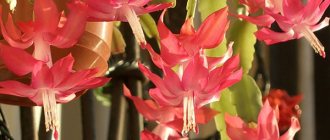This forest cactus called Decembrist has other names:
Dear readers! For you, we have created communities on social networks in which useful articles and interesting ideas are published several times a day! Subscribe and receive useful content in a convenient format!
- Christmas cactus:
- Schlumberger;
- Zygocactus.
Since this is a forest cactus, if we replant it according to all the rules and on time, we will get a beautifully flowering bush.
How to determine if a flower needs replanting
The most important reason is replanting the flower after purchase - this is especially true for those specimens that come from Holland. They are grown in peat, which is not suitable for permanent cultivation and is only suitable for greenhouse conditions. Therefore, the flower is transplanted into properly selected soil. If you do not replant the leaves, the segments will become depleted and wither, which will lead to the death of the flower.- The root system of the flower peeks out from the drainage holes of the container - this indicates that the plant has completely mastered the container in which it lives and requires a planned transplant into a new pot of a slightly larger diameter.
Lighting
You will be interested in: How to grow aloe at home: breeding options, planting rules, recommendations for growing and care
Zygocactus needs a sufficient amount of light, but not bright and diffused. Direct sunlight can damage the delicate leaves of the flower. In spring and summer, when the sun is especially active, the Decembrist should be artificially shaded.
During flowering, zygocactus is especially sensitive to light. The wayward plant does not like when its position relative to the sun changes abruptly. Experienced flower growers advise moving the Decembrist plant as little as possible. Otherwise, he may react by dropping the buds ahead of time. Often the same reaction can be observed if you touch the flowers with your fingers.
How to replant after purchase
After purchasing, the flower must be replanted, completely getting rid of the peat. To do this, you need to carry out the necessary steps:
- Remove the flower from the transport pot:
- Remove peat completely;
- If it does not separate, it can be removed using a toothbrush, gently combing the roots in the direction from the root collar to the ends of the roots;
- After which the flower is inspected for the presence of pests and planted in new specialized soil.
Important! After purchase, the plant must be quarantined for about 2 weeks to determine whether it is infected or not with various pests.
When is the best time to transplant Schlumbergera?
A favorable time for replanting a plant is the period after flowering - from the end of February to May inclusive. The fact is that in the spring, the Decembrist, like any plant, enters an active vegetative phase: new cells begin to form intensively due to the acceleration of metabolic processes occurring in it.
The trigger for the active growth of zygocactus is favorable weather conditions (increased daylight hours, increased temperature), which are very similar to their “native” ones.
Reference! It is not recommended to replant the plant in summer and autumn. Otherwise, the Christmas tree may not bloom or lose all its foliage.
Is it possible to disturb a plant during flowering?
Decembrist flowering time is from December to February. During this period, it is very vulnerable and reacts painfully to the slightest changes by dropping buds. The only exception in which flowers can be sacrificed is to save the zygocactus due to fungal infection or rotting roots.
Immediately after purchase
Replanting after purchase must be done , since the plant is sold in low-nutrient transport soil. If the zygocactus is left in the same container, it will soon disappear.
Which pot to transplant into?
The right pot is half the battle to stimulate Decembrist flowering.
Since in a pot that is too large and spacious, the flower will grow the root system until it fills the entire space of the pot. There will be no flowering at this time.
At the same time, the roots of the Decembrist are located almost on the surface, so not a deep, but a wide pot will suit him.
Important! It is also necessary to have drainage holes through which irrigation can be carried out using the immersion method, and excess water will be drained after watering.
How to choose a pot and soil?
How to transplant a ficus at home to a new place
The choice of container for transplanting Decembrist is one of the important factors for the future development of the plant. Decembrist has a superficial root system, which means that the roots grow wider than deeper. Therefore, a shallow but wide container is suitable for the flower. You should not choose a pot that is too large, as the plant will try to fill the entire volume of the container with the root system and will not have the strength to flower. When transplanting Decembrist into a deep container, in the future there is a risk that the water at the bottom will stagnate and the soil will become waterlogged.
The recommended container size for transplantation is one tenth (about 2-3 centimeters) larger than the previous one. Suitable pot materials for a “Christmas” cactus are plastic, ceramics and clay. The plastic container maintains a constant soil temperature; the plastic itself has the ability to absorb excess moisture. The main advantages of ceramics and clay are their environmental friendliness. What kind of pot is needed for the Decembrist flower: the choice is up to the gardener. To prevent the soil in the container from overheating, it is desirable that it be light in color.
Pot for transplanting
Important! Holes for drainage at the bottom of the pot are a necessary condition for the proper development of the Decembrist. After watering, excess water is drained through these holes; you can also water the plant through them using the immersion method.
What soil should I choose for the first and planned replanting of the Decembrist plant? The flower loves soil saturated with organic matter, loose and well-permeable to moisture, with a slightly acidic acidity level that should not be higher than pH = 6.0. Soil from the garden is definitely not suitable. Flower shops sell a special substrate marked “For cacti.” The substrate contains the following ingredients: nutrients, coarse river sand, humus and peat.
You can prepare the soil yourself. Below are three soil options for Decembrist. For this you will need
- soil from the garden, coarse river sand and peat in a ratio of 1:1:1/2, respectively;
- leaf soil, turf soil, coarse river sand and peat in a ratio of 2:1:1:1, respectively;
- leaf and turf soils, coarse river sand, humus in a ratio of 1:1:1:1/4, respectively.
You can add small quantities to your own prepared soil: dry leaves, brick chips, vermiculite, small pieces of polystyrene foam and coal, soil “For Orchids”, which contains bark and coal.
Soil for the Decembrist
Important! Drainage is a necessary component in filling a flower pot for the Decembrist. Drainage removes excess moisture during watering. The following can be used as drainage: expanded clay, pebbles, small pebbles, brick fragments, pieces of polystyrene foam and wine corks.
What soil to replant in?
The soil can be purchased ready-made labeled “For cacti.” If you don’t have it, you can make it yourself by taking all the ingredients in equal proportions:
- Leaf soil - collected under trees in the forest away from roads;
- Turf land;
- Sand;
- ¼ part of humus.
You can also add a little soil “For Orchids” to this composed soil, which contains coal and bark. The soil should be nutritious and loose. And as it settles in the pot, it is added to the required level.
Soil made on your own requires sterilization. To do this, it is steamed for 20 minutes in the oven at 200 degrees. Or you can put it in the freezer of the refrigerator for a day.
Important! The soil must be loose, as this is an epiphytic plant.
What to feed Schlumbergera?
During the replanting process, the following types of fertilizers can be added to the soil mixture for Schlumbergera:
- Humus . Not only is it rich in nutrients, but it also retains these components in the root zone. The humus particles retain their elasticity, due to which there are air gaps between them for the root system to breathe.
- Wood ash . Serves as a natural mineral fertilizer. This fertilizer contains a large amount of potassium and phosphorus.
- Rotted compost . It will significantly increase flowering.
- Bone flour . Rich in phosphorus, which is responsible for root formation and bud formation.
You can find out what to feed Schlumbergera and how to care for it so that the plant blooms here.
Step-by-step instructions for transplanting Decembrist
For a beginner who is replanting a plant for the first time, it is best to adhere to all the replanting rules given below. Otherwise, violations and errors can lead to the death of the plant.
Basic requirements for plant transplantation:
- First, you should purchase a pot of the required shape and size. The shape of the container should be such that the width exceeds the height of the pot. The size needed is slightly larger than the previous pot so that the flower begins to bloom in the first winter. If you take the pot to grow, the plant will take a long time to grow its root system and will not bloom.
- We purchase the necessary soil or make it ourselves.
- At the bottom of the planting container we place a 2 cm layer of drainage and a little soil.
- We take the Decembrist out of the old pot and carefully shake off its roots so that the excess soil is sprinkled.
- After that, holding it with your hands, transfer it to a new pot and place it on the ground in the center of the container.
- Holding the flower with your left hand, pour fresh specialized soil around the root system of the plant with your right.
- When filling the pot with soil, there is no need to press it down. After watering, some of it will shrink, and then it will be necessary to fill it up to the required level.
Important! The first watering is carried out only on the third day. However, it should be produced with warm water and not in large quantities. And for the first two weeks it is better to spray the flower with warm water.
Description of the plant
Schlumbergera is native to South America. The flower belongs to the cactus family, despite the absence of the usual spines. In the wild, zygocactus is located on tree branches; it is accustomed to a hot and humid climate. At the same time, the Decembrist does not parasitize, feeding on the sap of the trees on which it grows. It obtains nutrients and moisture from precipitation and dust.
Decembrist is a subshrub whose long vines consist of small rounded or jagged segments up to 6 cm in length. The plant blooms with multi-tiered oblong-shaped flowers. In the wild, Decembrist inflorescences are red or white. But through the efforts of breeders, other color variations and shapes of the plant’s petals were developed.
The root system of zygocactus cannot be called powerful, but it is notable for its “searching” roots, which contribute to the amazing survival of the species. Thanks to its memorable external characteristics, the Decembrist quickly gained popularity among lovers of original plants.
How to plant Decembrist
This flower is quite easy to propagate. Even a novice gardener can do this. To do this, it is enough after flowering, when new growth of segments begins, to unscrew the cuttings with 2-3 adult segments clockwise and use them to propagate the plant. Also, such cuttings are formed after annual pruning, which is carried out after flowering.
There are two ways to germinate roots from cuttings:
- In water.
- In the ground.
Reproduction of Decembrist in water
The cuttings are unscrewed and placed in water to grow roots. In this case, only the lowest petiole is immersed in water, not forgetting to dry it for 3 hours after unscrewing. If the water becomes cloudy the next day, it is poured out and the cuttings are washed under running water.
After this, a tablet of activated carbon is added to the new water, and the cutting is placed again to build up the root mass.
Reproduction of the Decembrist in the ground
The cuttings are unscrewed and dried.
After this, take small containers filled with specialized soil. In the center, make a 2-3 cm depression with your finger or a pencil and plant the cuttings, deepening them by 1/3 of the segment.
If the room has good humidity and warmth, there is no need to cover the cuttings with anything. But if the room is very hot and dry, then it is worth covering such cuttings with a glass jar, but daily ventilation will be necessary. Because without them, a fungus can develop on the cutting from excess greenhouse humidity, which will lead to the death of the cutting.
Flower propagation
Zygocactus is a fairly hardy plant, the propagation of which is not particularly difficult. The easiest way to do this is vegetatively. The most suitable time is the beginning of May or the period immediately after the end of flowering. Cuttings are considered an effective procedure.
Cuttings are torn from the Decembrist in the same way that was used for pruning. The required shoot length is 3-4 links. The twisted cuttings need to be dried for several hours, after which they can be planted in moist soil. Having finished planting, the flowers should be covered, for which transparent plastic cups are ideal.
Little Decembrists need shade, so they need to be placed in a well-ventilated place protected from sunlight. Periodically, the soil with seedlings should be moistened. The time when it is permissible to transplant a Decembrist seedling into permanent soil comes within a month. With proper care, young plants bloom in their second year.
Source
Care after transplant
After transplanting a flower, it is necessary to organize conditions that are comfortable for it, which are close to those in its homeland:
- The air temperature for the Decembrist should be within 16-18 degrees in winter, and in summer he prefers temperature limits of 23-26 degrees Celsius.
- Humidity should be average. The flower will have nothing against spraying with warm water once a week in the summer.
- Direct sunlight in the summer may well destroy the plant; it prefers partial shade in the summer and walking in the fresh air.
Since in summer the flower grows its segments, it must be turned once a month in relation to the sun's rays so that the plant does not fall on its side towards the light source.
At the same time, twice a month Decembrist is fertilized with fertilizer intended for cacti.
Important! Dilute the fertilizer according to the instructions given on the package and water only on moist soil so as not to burn the root system of the flower.
Caring for zygocactus: difficulties and recommendations
Difficulties encountered before or after transplantation:
- There are rotten roots in the root system. A sharp knife should be disinfected and unhealthy areas should be removed. Crush the activated carbon and sprinkle it on the cut areas. You also need to change the plant's watering scheme. If most of the roots turn out to be rotten, then it is better to take flower cuttings.
- The Decembrist began to fade. This is possible when direct sunlight hits the plant. Move the container to another location.
- The stems began to dry out and die. This could happen due to severe trauma to the root system. Dead stems - remove. Next you need to observe the zygocactus. Another transplant may be needed.
- Shoots grow poorly. It is worth reviewing the care system. Watering and location of the flower.
General recommendations:
- The most important period after transplantation is the first 2-3 weeks. Since the plant is under stress at this time. You cannot water Schlumbergera for the first 3-4 days. The only important thing is frequent spraying. The transition to watering should be smooth.
- During the first two months, you should not feed the plant. You need to give the flower time to adapt to new conditions.
- If the zygocactus has taken root, its shoots can be “pinched” to stimulate the formation of new branches. Also, thanks to this, flowering will be abundant and long-lasting.
To summarize:
- It is better to replant Decembrist in the spring, during the period of active growth and development. In winter, this can damage all the buds of the plant. If the zygocactus is young, then replanting is needed annually; if an adult – once every 3 years; for large ones – once every 5 years.
- The pot should be only a couple of centimeters in width larger than the previous one. You can buy soil in a store labeled “for cacti” or make it at home.
- Transplantation is a fairly simple process, the main thing is to follow the step-by-step instructions. And in the first 3-4 days, do not water the flower. It should also be left alone for 2-3 weeks in a cool, dark place.
How to water after transplanting
Immediately after transplantation, water on the third day.
This is necessary so that all the roots injured during transplantation of the Decembrist forest cactus can heal. Further watering depends on the time of year. In summer, water once a week, but when the temperature rises above 35 degrees, if there is no room with air conditioning, it is necessary to reduce watering and increase spraying of the bush.
Since at high temperatures the flower can fall into stagnation, and at the same time the root system stops absorbing water and can begin to rot.
In winter, water carefully. If the apartment is warm and the plant is blooming, then it is watered in the summer mode. If the air temperature in the apartment drops to +16, watering is reduced to prevent the flower from rotting.
Important! Watering is done only with settled and warm water, so as not to cause stress to the plant.
Temperature and humidity
The home Decembrist prefers high air humidity, so it is recommended to regularly spray its foliage with water. But moisture should not get on the sensitive flower buds and soil. The zygocactus will also be grateful for water treatments: the pot with the plant is periodically placed on a tray with wet pebbles.
It is not difficult to recreate a suitable temperature regime for the Decembrist. The optimal temperature for it varies from +18 to +28 °C. Therefore, the zygocactus will feel quite comfortable in the room.
In summer, the plant is kept on the balcony to provide its root system with greater access to oxygen. In winter, it is recommended to reduce the temperature to +15 °C, but not lower than +12 °C. During the flowering period, Decembrist needs +20 °C. The main thing you need to know is that the flower does not tolerate sudden changes in temperature.
Let's get to work: transplanting the Decembrist
When planning to plant Decembrist at home, a beginner will have to collect special information and find out the nuances, and in addition, prepare everything necessary for work. This amazing cactus is so unpretentious and hardy that even completely inexperienced amateur gardeners are unlikely to make fatal mistakes, so there is no need to worry too much. The main thing is to do everything clearly and according to the suggested tips; otherwise, the flower will take care of itself, because you won’t even have to water it too often.
Transportation, pots and mode
First of all, many are interested in what to do with Decembrist immediately after purchase, since in the store it grows in an unreliable shipping container. These are pots made of thin plastic, very fragile and rarely beautiful. Regardless of the time of year, weather and other factors, it is better to immediately transplant the zygocactus from such a container, otherwise it may be uncomfortable, because often there is not even any soil there, just a layer of airy peat, and even that is not too dense. An excellent solution would be pots made from a wide variety of materials.
- Pure clay or ceramics.
- Glass.
- Wooden small boxes.
- Plastic flowerpots specially designed for growing flowers.
- Metal pallets can be used, but with extreme caution. If not properly cared for, they can become corroded, which can lead to rotting of the roots and death of the plant. Moreover, often even a transplant does not help in the end.
Young plants should definitely be replanted annually, so they will feel better, begin to grow a crown and throw out more and more flowers. However, as you age, it is better to stop at the transplant regimen once every two to three years. It is generally better not to touch old plants, but if you wish, you can cut shoots from it and grow a new young cactus.
Perfect time
To figure out when you can replant a Decembrist flower, you need to find out what its life cycle is. The flowering period begins approximately with the beginning of winter, which is why it received the popular name Christmas tree. This period lasts quite a long time, at least two months. It is clear that you should not manipulate the plant at this time, since it will definitely experience stress and may get sick and even die.
That is, to the question whether it is possible to replant a blooming Decembrist, the answer is strictly negative. The rest of the time, from approximately March to early November, transplanting Decembrist is quite acceptable. Moreover, it is better to let it be spring than late autumn, because then the cactus begins to prepare for a new flowering, gathers all its strength and its life “routine” should not be disrupted.
If there is no way out and you have to replant the flowerpot, for example, at the end of autumn, then you should be prepared for the fact that it will not bloom at all this year or will throw out only a few inflorescences. That is, you can replant Decembrist in November, but hardly anyone can vouch for the results.
Correct soil
Ideally, you just need to go to a specialty store and purchase soil suitable for cacti and succulents. It is also ideal for the Decembrist, being quite airy and loose. However, such an opportunity may not be available for a variety of reasons, so it is worth learning how to make suitable soil for plants yourself, especially since this is quite possible and will not be difficult.
- The pots should not be very deep, but wide; the cactus will feel better in them.
- Place expanded clay or small washed river pebbles on the bottom of the pot. If you take ingredients from the street, it doesn't hurt to bake them in the oven for a few minutes to kill pathogens and parasites.
- It is a good idea to use dried ground sphagnum (peat or white moss) for the soil. It will provide the necessary nutrients, as well as the necessary texture and breathability of the soil.
- To two parts of pre-calcined sand, add one part of leaf soil, and mix everything thoroughly. Add sphagnum moss and, if possible, some ground pebbles or expanded clay to make the soil more rocky.
Pour this soil over the drainage, after which you can immediately begin planting the zygocactus. Make sure that the layers are approximately the same, the Decembrist loves this and will reward it with good flowering. Many people recommend adding one part of peat to the soil; this is advisable when the plant is weakened or you want to rejuvenate it. The main thing is not to overdo it, because this is not always advisable.
Transfer rules
Correctly transplanting Decembrist at home is not as difficult as someone might think. Having prepared everything you need, you can start working, stocking up on gloves and special devices in the form of shovels and other equipment.
- Remove the plant from the shipping container or old pot. It will be easier to do this if you first soften the soil by moistening it generously with water.
- Place the roots of the plant in a pot where drainage and half of the soil have been previously laid, trying to ensure that they do not interfere with each other.
- Holding the plant by the stem, fill in the remaining soil, lightly pressing and pressing it with your fingers.
Any manipulation of a plant, especially replanting, is serious stress and trauma, so you need to give it rest and support. After replanting the plant, you need to water it lightly and then place it in a dark and slightly cool place. You shouldn’t put the cactus in the pantry; it’s better to just move it deep into the room from the windowsill, that will be quite enough. It is in such a place that high-quality and gradual adaptation of Schlumbergera to new growing conditions should take place.
As soon as you find that the plant has returned to normal, and its buds and shoots have come to life and began to sprout, throwing out new leaves, you can gradually expose it to the light. However, direct sunlight is not the best choice for this plant, ideally the light should be slightly diffused, as if it were under the canopy of taller trees, simulating a natural environment. Many housewives cut out openwork lace from paper and paste it on the windows to create ideal conditions for the Decembrist, but it’s up to you to decide how exactly to deal with such nuances.











